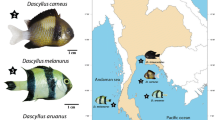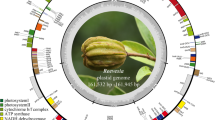Summary
Chloroplast DNA variation has been used to examine some of the maternal lineages involved in the evolution of the intraspecific polyploid complex, Dactylis glomerata L. Diploid (2x) and tetraploid (4x) individuals were collected from natural populations of the subspecies glomerata (4x), marina (4x) and lusitanica (2x), as well as from sympatric 2x/4x populations of the Galician type. Digestion of their ctDNA with 11 restriction endonucleases revealed enough variation to characterise three ctDNA variants, designated MBMK, MBmK and mBMK. The distribution of these ctDNA variants reflects different stages in their spread among the populations. The MBMK ctDNA variant predominated at both ploidy levels in subspecies glomerata, lusitanica and marina, and in recent tetraploid Galician/glomerata hybrids. The MBmK variant was detected in a single tetraploid individual and probably results from a relatively recent mutation. Fixation of the mBMK minority variant in the diploid and tetraploid Galician populations adds to the evidence concerning the possible origin of the Galician tetraploids. It means that the Galician diploids were maternal ancestors of the tetraploids. This result complements evidence from earlier studies based on morphology or biochemical markers, and reduces the likelihood that the tetraploids arose by hybridisation between an ancient Galician diploid and an alien tetraploid. It is, however, consistent with a true autopolyploid origin of the tetraploids.
Similar content being viewed by others
References
Ardouin P, Jay M, Lumaret R (1987) Etude d'une situation de sympatrie entre diploïdes et tetraploïdes sur la base du polymorphisme enzymatique et phénolique. Can J Bot 65:526–531
Banks JA, Birky CW (1985) Chloroplast DNA diversity is low in a wild plant, Lupinus texensis. Proc Natl Acad Sci USA 82:6950–6954
Barrientos E (1985) Evolution dans les complexes autopolyploïdes — Exemple de Dactylis glomerata L. (Graminée): étude comparative de la structure génétique des populations dans deux situations de contact entre diploïdes et tétraploïdes. Thesis Université Sciences et Techniques du Languedoc, Montpellier, pp 35–54
Borrill M (1978) Evolution and genetic resources in cocksfoot: Annual Report of the Welsh Plant Breeding Station 1977. University College Wales, Aberystwyth, pp 190–209
Borrill M, Linder R (1971) Diploid-tetraploid sympatry in Dactylis (Gramineae). New Phytol 70:1111–1124
Bowman CM, Dyer TA (1982) Purification and analysis of DNA from wheat chloroplasts isolated in nonaqueous media. Anal Biochem 122:108–118
Bowman CM, Bonnard G, Dyer TA (1983) Chloroplast DNA variation between species of Triticum and Aegilops; location of the variation on the chloroplast genome and its relevance to the inheritance and classification of the cytoplasm. Theor Appl Genet 65:247–262
Carroll CP (1966) Autopolyploïdy and the assortment of chromosomes. Chromosoma 18:19–43
Casler M, Huguessen P (1988) Performance of tetraploid progenies derived from 2x/4x inter-subspecific crosses in Dactylis glomerata L. Genome 30:591–596
Clausen J, Keck DD, Heisey WM (1945) Experimental studies on the nature of species. II. Plant evolution through amphiploidy and autoploidy with examples from the Madiinae. Carnegie Institute, Washington 564, p 174
Clegg MT, Brown AHD, Whitfeld PR (1984 a) Chloroplast DNA diversity in wild and cultivated barley: implications for genetics conservation. Genet Res Camb 43:339–343
Clegg MT, Rawson JRY, Thomas K (1984 b) Chloroplast DNA variation in pearl millet and related species. Genetics 106:449–461
Curtis SE, Clegg MT (1984) Molecular evolution of chloroplast DNA sequences. Mol Biol Evol 1:291–301
De Wet JMJ (1980) Origin of polyploids. In: Lewis WH (ed) Polyploidy-Biological relevance. Plenum Press, New York, pp 3–15
Dennijs TPM, Peloquin SJ (1977) 2n gametes in potato species and their function in sexual polyploidization. Euphytica 26:585–600
Erickson LR, Strauss NA, Beversdorf WD (1983) Restriction patterns reveal origins of chloroplast genomes in Brassica amphidiploids. Theor Appl Genet 65:201–206
Harlan JR, De Wet JM (1975) On Ö Winge and a prayer: the origins of polyploidy. Bot Rev 41:361–390
Huguessen P (1986) The occurrence and potential of 2n eggs in Dactylis. Masters Thesis, University of Wisconsin-Madison, pp 1–73
Jackson RC, Casey J (1982) Cytogenetics analysis of autopolyploids: models and methods for triploids to octoploids. Am J Bot 69:487–501
Kung SD, Zhu YS, Shen GF (1982) Nicotiana chloroplast genome. 3. Chloroplast DNA evolution. Theor Appl Genet 61:73–79
Lehvaslaiho H, Saura A, Lokki J (1987) Chloroplast DNA variation in the grass tribe Festuceae. Theor Appl Genet 74:298–302
Levin DA (1983) Polyploidy and novelty in flowering plants. Am Nat 122:1–25
Love A (1964) The biological species concept and its evolutionary structure. Taxon 13:33–45
Lumaret R (1985) Phenotypic and genotypic variation within and between populations of the polyploid complex, Dactylis glomerata L. In: Haeck J, Woldendorp JW (eds) Structure and functioning of plant populations/2, phenotypic and genotypic variation in plant populations. North-Holland, Amsterdam, pp 343–354
Lumaret R (1986) Doubled duplication of the structural gene for cytosolic phosphoglucose isomerase in the Dactylis glomerata L. polyploid complex. Mol Biol Evol 3:499–521
Lumaret R (1988) Cytology, genetics and evolution in the genus Dactylis. CRC Crit Rev Plant Sci 7:55–91
Lumaret R (1989) Invasion of natural pastures by a cultivated grass (Dactylis glomerata) in Galicia, Spain: Process and consequences on plant-cattle interactions. In: Di Castri F, Hansen AJ (eds) Biological invasions in Europe and the Mediterranean basin. Junk, La Hague (in press)
Lumaret R, Barrientos E (1989) Phylogenic relationships and gene flow between sympatric diploid and tetraploid plants of Dactylis glomerata L. Plant Syst Evol (in press)
Lumaret R, Guillerm JL, Delay J, Loutfi AAL, Izco J, Jay M (1987) Polyploidy and habitat differentiation in Dactylis glomerata L. from Galicia (Spain). Oecologia 73:436–446
McCollum GD (1958) Comparative studies of chromosome pairing in natural and induced tetraploid Dactylis. Chromosoma 9:571–605
Palmer JD (1987) Chloroplast DNA evolution and biosystematic uses of chloroplast DNA variation. Am Nat 130:S6-S29
Palmer JD, Zamir D (1982) Chloroplast DNA evolution and phylogenetic relationships in Lycopersicon. Proc Natl Acad Sci USA 79:5006–5010
Palmer JD; Shields CR, Cohen DB, Orton TJ (1983) Chloroplast DNA evolution and the origin of amphidiploid Brassica species. Theor Appl Genet 65:181–189
Salts Y, Herrmann RG, Peleg N, Lavi V, Izhar S, Frankel R, Beeckman JS (1984) Physical mapping of plastid DNA variation among eleven Nicotiana species. Theor Appl Genet 69:1–14
Soltis DE (1984) Autopolyploidy in Tolmiea menziesii (Saxifragaceae). Am J Bot 71:1171–1174
Soltis DE, Rieseberg LH (1986) Autopolyploidy in Tolmiea menziesii (Saxifragaceae): genetic insights from enzyme electrophoresis. Am J Bot 73:310–318
Stebbins GL, Zohary D (1959) Cytogenetic and evolutionary studies in the genus Dactylis. 1. Morphology distribution and interrelationships of the diploid subspecies. Univ California Publ Botany 31:1–40
Terachi T, Ogihara Y, Tsunewaki K (1984) The molecular basis of genetic diversity among cytoplasms of Triticum and Aegilops. III. Chloroplast genomes of the M and modified M genome-carrying species. Genetics 108:681–695
Tsunewaki K, Ogihara Y (1983) The molecular basis of genetic diversity among cytoplasms of Triticum and Aegilops species. II. On the origin of polyploid wheat cytoplasms as suggested by Chloroplast DNA restriction fragment patterns. Genetics 104:155–171
Vedel F, Quetier F, Cauderon Y, Dosba F, Doussinault G (1981) Studies on maternal inheritance in polyploid wheats with cytoplasmic DNAs as genetic markers. Theor Appl Genet 59:239–245
Zohary D, Nur U (1959) Natural triploids in orchard grass Dactylis glomerata L. polyploid complex and their significance for gene flow from diploid to tetraploid levels. Evolution 13:311–317
Author information
Authors and Affiliations
Additional information
Communicated by K. Tsunewaki
Rights and permissions
About this article
Cite this article
Lumaret, R., Bowman, C.M. & Dyer, T.A. Autopolyploidy in Dactylis glomerata L.: further evidence from studies of chloroplast DNA variation. Theoret. Appl. Genetics 78, 393–399 (1989). https://doi.org/10.1007/BF00265302
Received:
Accepted:
Issue Date:
DOI: https://doi.org/10.1007/BF00265302




